Jie Guo
IGDMRec: Behavior Conditioned Item Graph Diffusion for Multimodal Recommendation
Dec 23, 2025



Abstract:Multimodal recommender systems (MRSs) are critical for various online platforms, offering users more accurate personalized recommendations by incorporating multimodal information of items. Structure-based MRSs have achieved state-of-the-art performance by constructing semantic item graphs, which explicitly model relationships between items based on modality feature similarity. However, such semantic item graphs are often noisy due to 1) inherent noise in multimodal information and 2) misalignment between item semantics and user-item co-occurrence relationships, which introduces false links and leads to suboptimal recommendations. To address this challenge, we propose Item Graph Diffusion for Multimodal Recommendation (IGDMRec), a novel method that leverages a diffusion model with classifier-free guidance to denoise the semantic item graph by integrating user behavioral information. Specifically, IGDMRec introduces a Behavior-conditioned Graph Diffusion (BGD) module, incorporating interaction data as conditioning information to guide the denoising of the semantic item graph. Additionally, a Conditional Denoising Network (CD-Net) is designed to implement the denoising process with manageable complexity. Finally, we propose a contrastive representation augmentation scheme that leverages both the denoised item graph and the original item graph to enhance item representations. \LL{Extensive experiments on four real-world datasets demonstrate the superiority of IGDMRec over competitive baselines, with robustness analysis validating its denoising capability and ablation studies verifying the effectiveness of its key components.
LoG3D: Ultra-High-Resolution 3D Shape Modeling via Local-to-Global Partitioning
Nov 18, 2025



Abstract:Generating high-fidelity 3D contents remains a fundamental challenge due to the complexity of representing arbitrary topologies-such as open surfaces and intricate internal structures-while preserving geometric details. Prevailing methods based on signed distance fields (SDFs) are hampered by costly watertight preprocessing and struggle with non-manifold geometries, while point-cloud representations often suffer from sampling artifacts and surface discontinuities. To overcome these limitations, we propose a novel 3D variational autoencoder (VAE) framework built upon unsigned distance fields (UDFs)-a more robust and computationally efficient representation that naturally handles complex and incomplete shapes. Our core innovation is a local-to-global (LoG) architecture that processes the UDF by partitioning it into uniform subvolumes, termed UBlocks. This architecture couples 3D convolutions for capturing local detail with sparse transformers for enforcing global coherence. A Pad-Average strategy further ensures smooth transitions at subvolume boundaries during reconstruction. This modular design enables seamless scaling to ultra-high resolutions up to $2048^3$-a regime previously unattainable for 3D VAEs. Experiments demonstrate state-of-the-art performance in both reconstruction accuracy and generative quality, yielding superior surface smoothness and geometric flexibility.
StableIntrinsic: Detail-preserving One-step Diffusion Model for Multi-view Material Estimation
Aug 27, 2025



Abstract:Recovering material information from images has been extensively studied in computer graphics and vision. Recent works in material estimation leverage diffusion model showing promising results. However, these diffusion-based methods adopt a multi-step denoising strategy, which is time-consuming for each estimation. Such stochastic inference also conflicts with the deterministic material estimation task, leading to a high variance estimated results. In this paper, we introduce StableIntrinsic, a one-step diffusion model for multi-view material estimation that can produce high-quality material parameters with low variance. To address the overly-smoothing problem in one-step diffusion, StableIntrinsic applies losses in pixel space, with each loss designed based on the properties of the material. Additionally, StableIntrinsic introduces a Detail Injection Network (DIN) to eliminate the detail loss caused by VAE encoding, while further enhancing the sharpness of material prediction results. The experimental results indicate that our method surpasses the current state-of-the-art techniques by achieving a $9.9\%$ improvement in the Peak Signal-to-Noise Ratio (PSNR) of albedo, and by reducing the Mean Square Error (MSE) for metallic and roughness by $44.4\%$ and $60.0\%$, respectively.
GaRe: Relightable 3D Gaussian Splatting for Outdoor Scenes from Unconstrained Photo Collections
Jul 28, 2025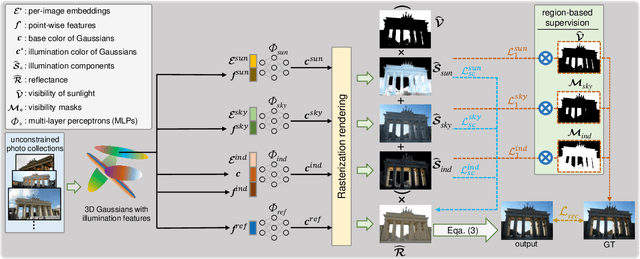
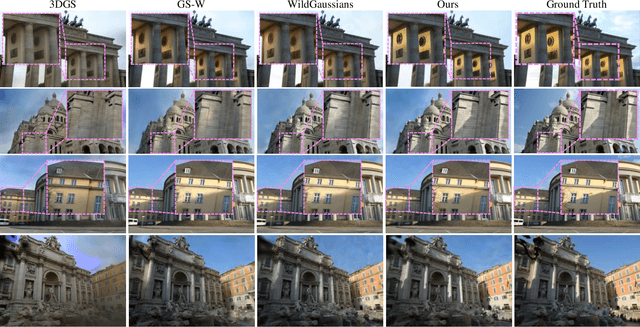
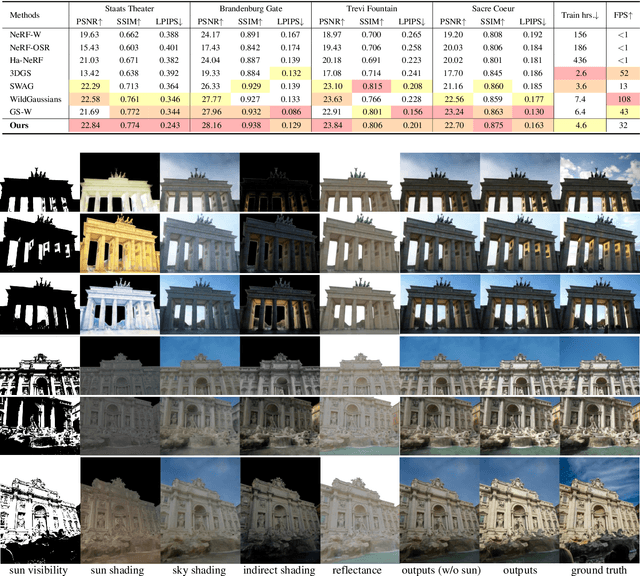
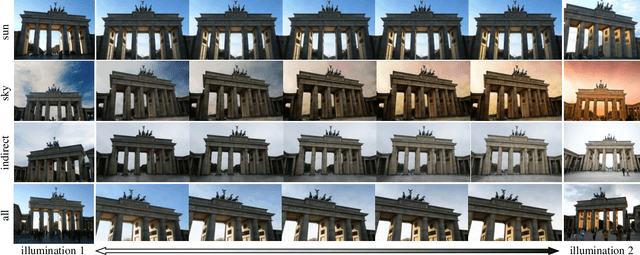
Abstract:We propose a 3D Gaussian splatting-based framework for outdoor relighting that leverages intrinsic image decomposition to precisely integrate sunlight, sky radiance, and indirect lighting from unconstrained photo collections. Unlike prior methods that compress the per-image global illumination into a single latent vector, our approach enables simultaneously diverse shading manipulation and the generation of dynamic shadow effects. This is achieved through three key innovations: (1) a residual-based sun visibility extraction method to accurately separate direct sunlight effects, (2) a region-based supervision framework with a structural consistency loss for physically interpretable and coherent illumination decomposition, and (3) a ray-tracing-based technique for realistic shadow simulation. Extensive experiments demonstrate that our framework synthesizes novel views with competitive fidelity against state-of-the-art relighting solutions and produces more natural and multifaceted illumination and shadow effects.
Test-Time-Matching: Decouple Personality, Memory, and Linguistic Style in LLM-based Role-Playing Language Agent
Jul 23, 2025



Abstract:The rapid advancement of large language models (LLMs) has enabled role-playing language agents to demonstrate significant potential in various applications. However, relying solely on prompts and contextual inputs often proves insufficient for achieving deep immersion in specific roles, particularly well-known fictional or public figures. On the other hand, fine-tuning-based approaches face limitations due to the challenges associated with data collection and the computational resources required for training, thereby restricting their broader applicability. To address these issues, we propose Test-Time-Matching (TTM), a training-free role-playing framework through test-time scaling and context engineering. TTM uses LLM agents to automatically decouple a character's features into personality, memory, and linguistic style. Our framework involves a structured, three-stage generation pipeline that utilizes these features for controlled role-playing. It achieves high-fidelity role-playing performance, also enables seamless combinations across diverse linguistic styles and even variations in personality and memory. We evaluate our framework through human assessment, and the results demonstrate that our method achieves the outstanding performance in generating expressive and stylistically consistent character dialogues.
TransparentGS: Fast Inverse Rendering of Transparent Objects with Gaussians
May 01, 2025



Abstract:The emergence of neural and Gaussian-based radiance field methods has led to considerable advancements in novel view synthesis and 3D object reconstruction. Nonetheless, specular reflection and refraction continue to pose significant challenges due to the instability and incorrect overfitting of radiance fields to high-frequency light variations. Currently, even 3D Gaussian Splatting (3D-GS), as a powerful and efficient tool, falls short in recovering transparent objects with nearby contents due to the existence of apparent secondary ray effects. To address this issue, we propose TransparentGS, a fast inverse rendering pipeline for transparent objects based on 3D-GS. The main contributions are three-fold. Firstly, an efficient representation of transparent objects, transparent Gaussian primitives, is designed to enable specular refraction through a deferred refraction strategy. Secondly, we leverage Gaussian light field probes (GaussProbe) to encode both ambient light and nearby contents in a unified framework. Thirdly, a depth-based iterative probes query (IterQuery) algorithm is proposed to reduce the parallax errors in our probe-based framework. Experiments demonstrate the speed and accuracy of our approach in recovering transparent objects from complex environments, as well as several applications in computer graphics and vision.
CombatVLA: An Efficient Vision-Language-Action Model for Combat Tasks in 3D Action Role-Playing Games
Mar 12, 2025
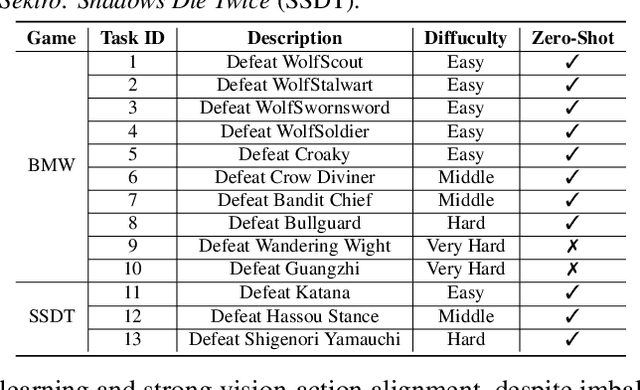
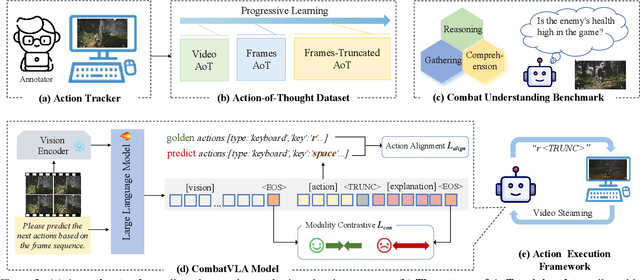
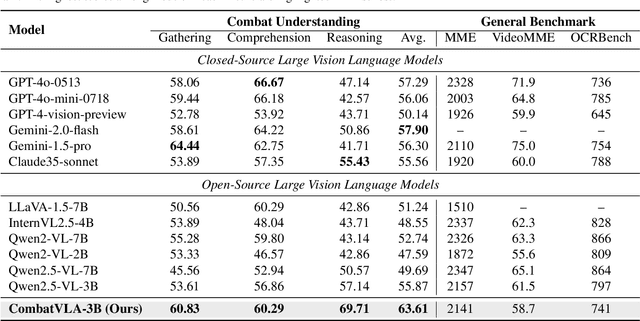
Abstract:Recent advances in Vision-Language-Action models (VLAs) have expanded the capabilities of embodied intelligence. However, significant challenges remain in real-time decision-making in complex 3D environments, which demand second-level responses, high-resolution perception, and tactical reasoning under dynamic conditions. To advance the field, we introduce CombatVLA, an efficient VLA model optimized for combat tasks in 3D action role-playing games(ARPGs). Specifically, our CombatVLA is a 3B model trained on video-action pairs collected by an action tracker, where the data is formatted as action-of-thought (AoT) sequences. Thereafter, CombatVLA seamlessly integrates into an action execution framework, allowing efficient inference through our truncated AoT strategy. Experimental results demonstrate that CombatVLA not only outperforms all existing models on the combat understanding benchmark but also achieves a 50-fold acceleration in game combat. Moreover, it has a higher task success rate than human players. We will open-source all resources, including the action tracker, dataset, benchmark, model weights, training code, and the implementation of the framework at https://combatvla.github.io/.
"I know myself better, but not really greatly": Using LLMs to Detect and Explain LLM-Generated Texts
Feb 18, 2025Abstract:Large language models (LLMs) have demonstrated impressive capabilities in generating human-like texts, but the potential misuse of such LLM-generated texts raises the need to distinguish between human-generated and LLM-generated content. This paper explores the detection and explanation capabilities of LLM-based detectors of LLM-generated texts, in the context of a binary classification task (human-generated texts vs LLM-generated texts) and a ternary classification task (human-generated texts, LLM-generated texts, and undecided). By evaluating on six close/open-source LLMs with different sizes, our findings reveal that while self-detection consistently outperforms cross-detection, i.e., LLMs can detect texts generated by themselves more accurately than those generated by other LLMs, the performance of self-detection is still far from ideal, indicating that further improvements are needed. We also show that extending the binary to the ternary classification task with a new class "Undecided" can enhance both detection accuracy and explanation quality, with improvements being statistically significant and consistent across all LLMs. We finally conducted comprehensive qualitative and quantitative analyses on the explanation errors, which are categorized into three types: reliance on inaccurate features (the most frequent error), hallucinations, and incorrect reasoning. These findings with our human-annotated dataset emphasize the need for further research into improving both self-detection and self-explanation, particularly to address overfitting issues that may hinder generalization.
ArtCrafter: Text-Image Aligning Style Transfer via Embedding Reframing
Jan 03, 2025



Abstract:Recent years have witnessed significant advancements in text-guided style transfer, primarily attributed to innovations in diffusion models. These models excel in conditional guidance, utilizing text or images to direct the sampling process. However, despite their capabilities, direct conditional guidance approaches often face challenges in balancing the expressiveness of textual semantics with the diversity of output results while capturing stylistic features. To address these challenges, we introduce ArtCrafter, a novel framework for text-to-image style transfer. Specifically, we introduce an attention-based style extraction module, meticulously engineered to capture the subtle stylistic elements within an image. This module features a multi-layer architecture that leverages the capabilities of perceiver attention mechanisms to integrate fine-grained information. Additionally, we present a novel text-image aligning augmentation component that adeptly balances control over both modalities, enabling the model to efficiently map image and text embeddings into a shared feature space. We achieve this through attention operations that enable smooth information flow between modalities. Lastly, we incorporate an explicit modulation that seamlessly blends multimodal enhanced embeddings with original embeddings through an embedding reframing design, empowering the model to generate diverse outputs. Extensive experiments demonstrate that ArtCrafter yields impressive results in visual stylization, exhibiting exceptional levels of stylistic intensity, controllability, and diversity.
InterDance:Reactive 3D Dance Generation with Realistic Duet Interactions
Dec 22, 2024



Abstract:Humans perform a variety of interactive motions, among which duet dance is one of the most challenging interactions. However, in terms of human motion generative models, existing works are still unable to generate high-quality interactive motions, especially in the field of duet dance. On the one hand, it is due to the lack of large-scale high-quality datasets. On the other hand, it arises from the incomplete representation of interactive motion and the lack of fine-grained optimization of interactions. To address these challenges, we propose, InterDance, a large-scale duet dance dataset that significantly enhances motion quality, data scale, and the variety of dance genres. Built upon this dataset, we propose a new motion representation that can accurately and comprehensively describe interactive motion. We further introduce a diffusion-based framework with an interaction refinement guidance strategy to optimize the realism of interactions progressively. Extensive experiments demonstrate the effectiveness of our dataset and algorithm.
 Add to Chrome
Add to Chrome Add to Firefox
Add to Firefox Add to Edge
Add to Edge